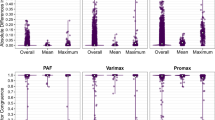Abstract
Recent advances in computer based psychometric techniques have yielded a collection of powerful tools for analyzing nonmetric data. These tools, although particularly well suited to the behavioral sciences, have several potential pitfalls. Among other things, there is no statistical test for evaluating the significance of the results. This paper provides estimates of the statistical significance of results yielded by Kruskal's nonmetric multidimensional scaling. The estimates, obtained from attempts to scale many randomly generated sets of data, reveal the relative frequency with which apparent structure is erroneously found in unstructured data. For a small number of points (i.e., six or seven) it is very likely that a good fit will be obtained in two or more dimensions when in fact the data are generated by a random process. The estimates presented here can be used as a bench mark against which to evaluate the significance of the results obtained from empirically based nonmetric multidimensional scaling.
Similar content being viewed by others
References
Green, B. F. The computer revolution in psychometries.Psychometrika, 1966,31, 437–445.
Green, P. E., Carmone, F. J., & Robinson, P. S. Nonmetric scaling: An exposition and overview.Wharton Quarterly, 1968,3.
Klahr, D. Decision making in a complex environment.Management Science, 1969 (forthcoming).
Kruskal, J. B. Multidimensional scaling by optimizing goodness of fit to a nonmetric hypothesis.Psychometrika, 1964,29, 1–27. (a)
Kruskal, J. B. Nonmetric multidimensional scaling: A numerical method.Psychometrika, 1964,29, 28–42. (b)
Lingoes, J. C. An IBM 7090 program for Guttman-Lingoes smallest space analysis—I.Behavioral Science, 1965,10, 183–184.
Russell, P. N., & Gregson, R. A. A comparison of intermodal and intramodal methods in multidimensional scaling of three-component taste mixtures.Australian Journal of Psychology, 1967,18, 244–254.
Shepard, R. N. The analysis of proximities: Multidimensional scaling with an unknown distance function, I.Psychometrika, 1962,27, 125–140. (a)
Shepard, R. N. The analysis of proximities: Multidimensional scaling with an unknown distance function, II.Psychometrika, 1962,27, 219–264. (b)
Shepard, R. N. Analysis of proximities as a technique for the study of information processing in man.Human Factors, 1963,5, 33–48.
Shepard, R. N. Metric structures in ordinal data.Journal of Mathematical Psychology, 1966,3, 287–315.
Stenson, H. H., & Knoll, R. L. Goodness of fit for random rankings in Kruskal's nonmetric scaling procedure.Psychological Bulletin, 1969,71, 122–126.
Torgerson, W. S. Multidimensional scaling of similarity.Psychometrika, 1965,30, 379–393.
Author information
Authors and Affiliations
Additional information
A preliminary version of this paper was presented at the International Federation for Information Processing Congress 68 in Edinburgh, Scotland, August 5–10, 1968.
Rights and permissions
About this article
Cite this article
Klahr, D. A monte carlo investigation of the statistical significance of Kruskal's nonmetric scaling procedure. Psychometrika 34, 319–330 (1969). https://doi.org/10.1007/BF02289360
Received:
Revised:
Issue Date:
DOI: https://doi.org/10.1007/BF02289360




